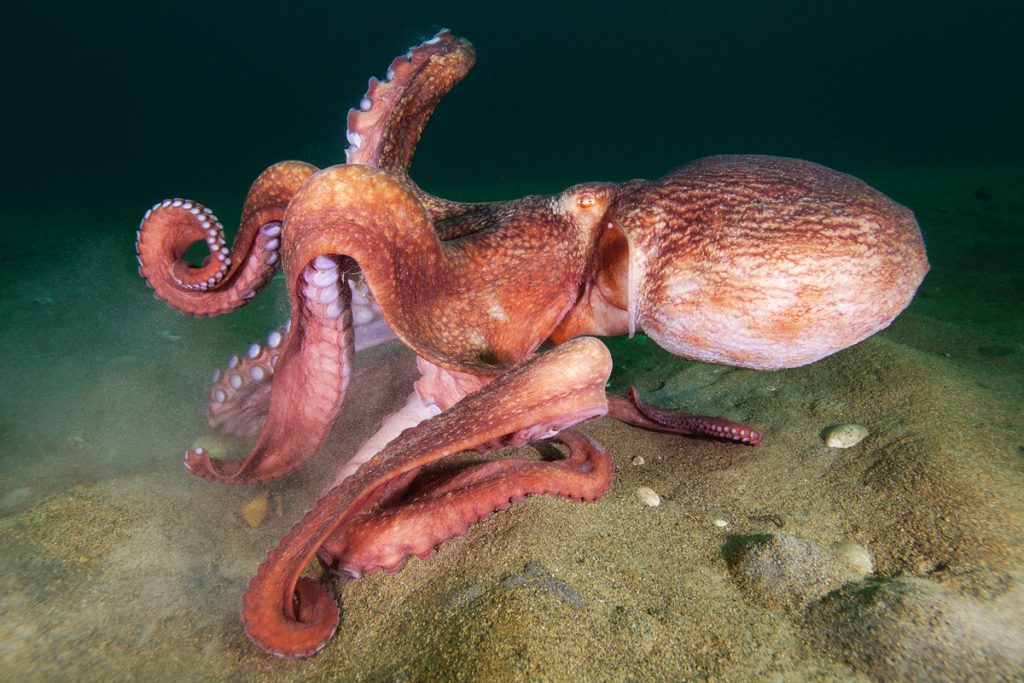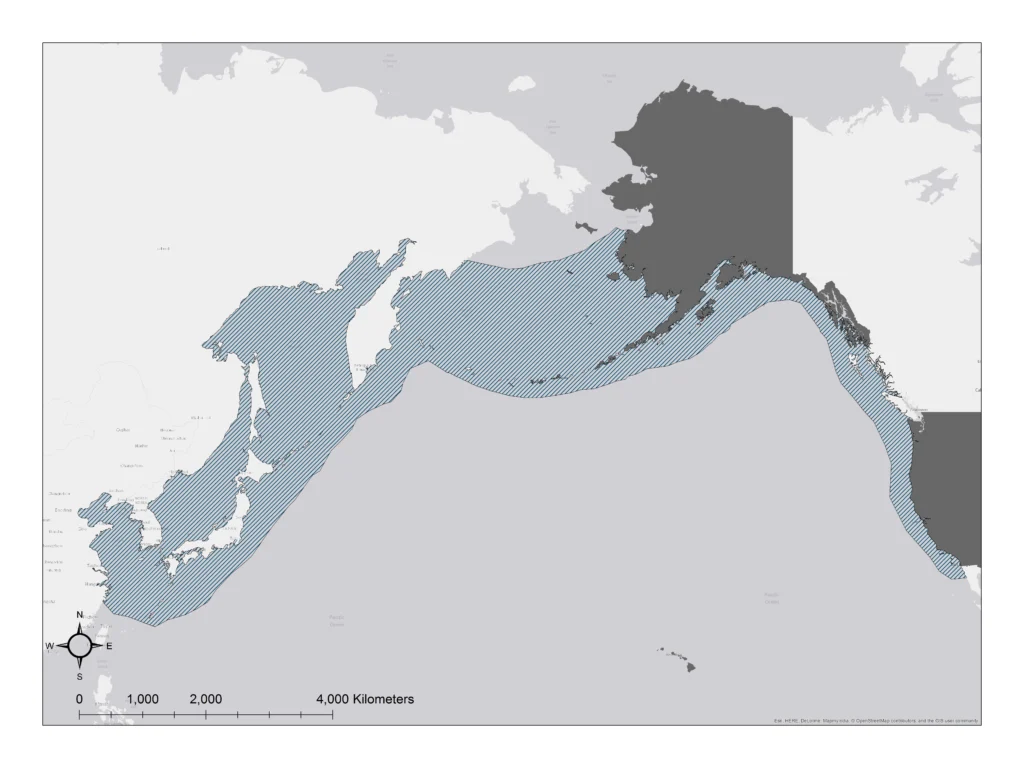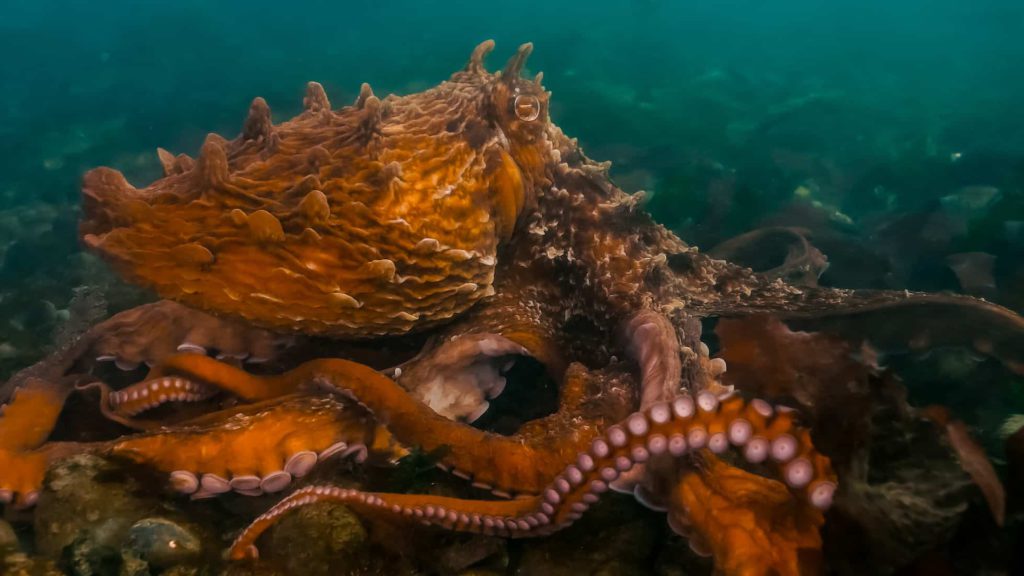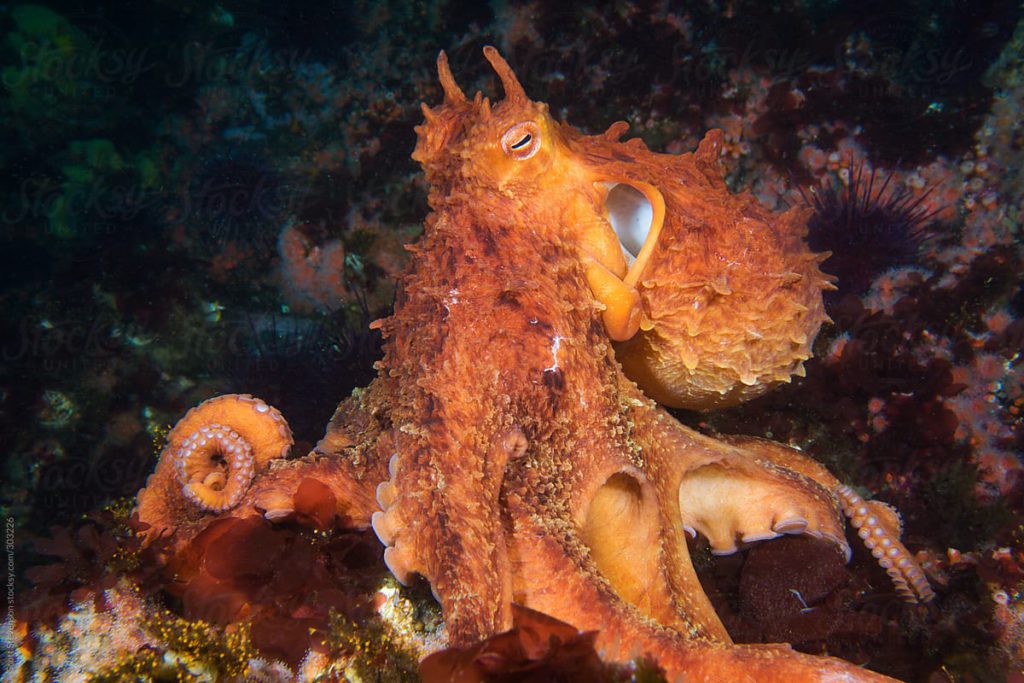Giant Pacific Octopus (Enteroctopus dofleini)- the largest representative of cephalopods on the planet. This incredible creature impresses with its size, intelligence, camouflage ability and complex behavior. Octopuses not only have unique anatomical features, but also show a high level of intelligence, which includes solving problems, using tools, and even recognizing people.
This article will tell you about the biological features of the giant Pacific octopus, its habitat, lifestyle, reproduction, food habits, defense mechanisms and interesting facts.

1. General characteristics and scientific classification
🔬 Scientific classification:
✔ The Kingdom: Animals (Animalia)
✔ Type: Shellfish (Mollusca)
✔ Class: Cephalopods (Cephalopoda)
✔ Row: Octopus (Octopoda)
✔ Family: Octopus plants (Octopodidae)
✔ Gender: Enteroctopus
✔ View: Giant Pacific Octopus (Enteroctopus dofleini)
2. Description and physical characteristics
✔ Size: On average, 3-5 meters in armspan, record individuals reached 9 meters.
✔ Weight: Usually 15-50 kg, the largest recorded octopus weighed 272 kg
✔ Life span: 3-5 years old
🔹 Appearance features:
✔ Soft, flexible body that allows you to penetrate narrow crevices
✔ Eight long arms studded with suction cups (up to 280 each)
✔ Color varies from reddish-brown to light orange
✔ It has skin papillae that help change the texture of the skin
🔹 Interesting facts:
✔ Octopus can change the color and texture of the skin thanks to special pigment cells-chromatophores
Its nervous system contains up to 500 million neurons, most of them in its tentacles

3. Habitat and habitat
🌍 Where does it live?
✔ Cold waters of the North Pacific Ocean
✔ From Japan to California, including the Aleutian Islands
📍 Typical habitats:
✔ Rocky reefs
✔ Underwater caves and gorges
✔ Muddy and sandy depths
🔹 Adapting to the environment:
✔ Withstands temperatures from 7°C to 15°C
✔ Leads a predominantly bottom-dwelling lifestyle
✔ Uses caves and crevices as a shelter
4. intelligence and behavior
🔹 Key features of intelligence:
✔ Solves logical tasks, such as opening banks
✔ Uses objects as tools (for example, coconut shells as a shelter)
✔ Remembers people and can distinguish them
🔹 Communication methods:
✔ Color change-alarm, aggression or disguise signal
✔ Using tentacle movements to interact
🔹 Defense mechanisms:
✔ Release ink liquid to disorient predators
✔ Mimic other marine animals (such as venomous fish)
✔ High escape speed thanks to jet propulsion

5. food and hunting
🍽 What does it eat?
✔ Crayfish, crabs, and shellfish
✔ Fish and even small sharks
✔ Other octopuses
🔹 Hunting methods:
✔ Using suction cups to hold prey
✔ Injecting toxic saliva that paralyzes the victim
✔ Breaking crustacean shells with a powerful beak
6. reproduction and life cycle
💞 Reproductive Biology:
✔ Males use a special tentacle (hectocotylus) to transfer the spermatophore to the female
✔ After fertilization, the female lays up to 100,000 eggs
✔ It guards the clutch for several months, refusing to eat, and eventually dies after the hatchlings hatch
🔹 Stages of development:
Larvae swim in the water column for the first few weeks
✔ They settle to the bottom and begin to grow, changing color in accordance with the environment

7. human interaction
🔹 Are they dangerous to humans?
✔ Non-aggressive, usually avoid contact
✔ Can defend themselves if there is a threat
🔹 Industrial value:
✔ They are caught for food purposes (especially in Japan and Korea)
✔ Used in scientific research because of their unique intelligence
🔹 Population threats:
✔ Ocean pollution
✔ Overfishing of marine animals included in their diet
8. Interesting facts about the giant octopus
✔ The octopus can shrink and penetrate crevices several times smaller than its size
✔ Has three hearts: two pump blood to the gills, and one - throughout the body
✔ His blood is blue due to its high hemocyanin content
✔ Octopuses can lose their tentacle and regenerate it within a few months
Conclusion
The giant Pacific octopus is a unique creature that combines strength, intelligence, and extraordinary adaptive abilities. It plays an important role in marine ecosystems, controlling the abundance of crustaceans and mollusks. Octopuses continue to amaze scientists with their behavior and learning abilities, making them one of the most mysterious creatures of the deep.
With each new study, we are learning more and more about these amazing animals and may soon learn even more incredible facts about their intelligence and lifestyle. 🌊🐙